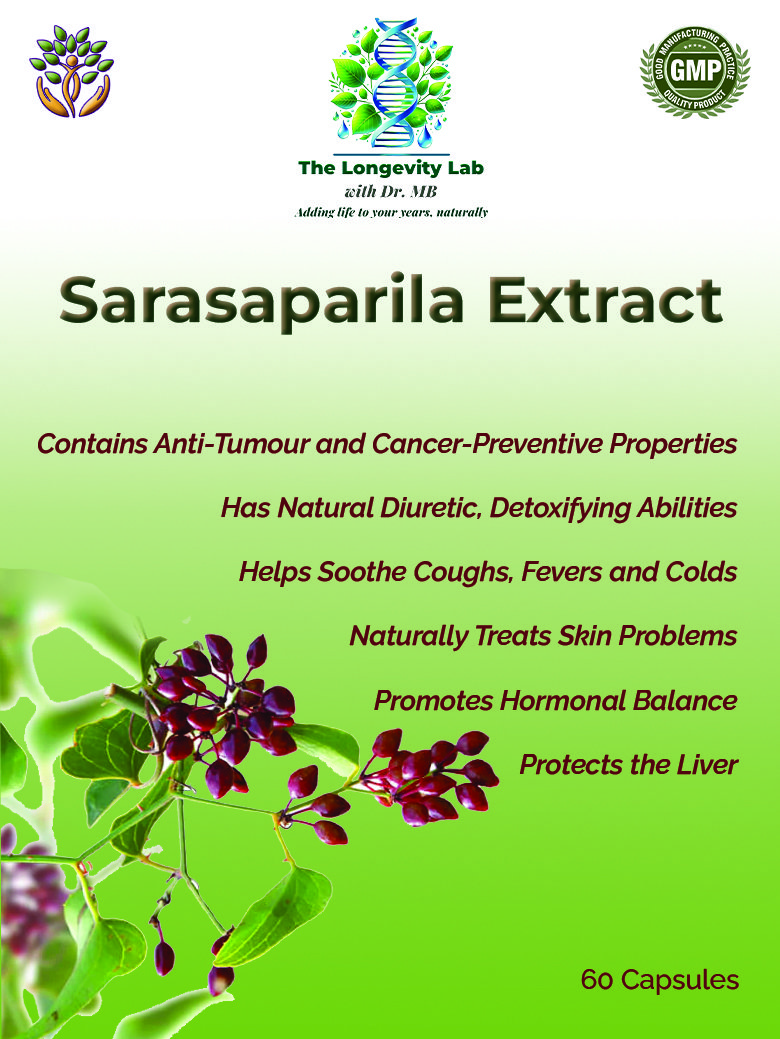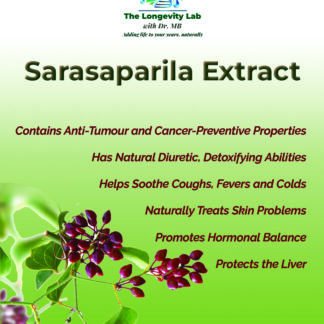Description
Dr MB’s Sarsaparilla Extract
Sarsaparilla : The Healing Herb
Sarsaparilla (which has the species names Smilax Ornata, Smilax regelii or Smilax officinalis) is a perennial vine that grows in warm temperatures, such as those in India, southern most states of the U.S. or Central and South America.
The plant is a member of the Liliaceae (lily) group of vines in the plant family called Smilacaceae, which according to the USDA includes over 300 different plant species.
In herbal medicine practices, sarsaparilla plant roots are ground up and used to make natural remedies (tinctures, teas, supplements, etc.) that help treat some of the following health problems:
- Cancer and tumour growth
- Coughs and colds
- Rheumatoid arthritis pains, joint pain or rheumatism
- Skin problems, including eczema, psoriasis, toe fungus, wounds, ulcers and ringworm
- Fatigue
- Muscle pains or weakness
- Low libido and sexual impotence
- Headaches
- Gout
- Indigestion
- Liver damage
- Infections, such as sexually transmitted diseases like syphilis and gonorrhea
- Bloating/fluid retention
- Overheating and fevers
Benefits
1. Contains Anti-Tumor and Cancer-Preventive Properties
According to certain studies that have found it contains at least 24 extracts that can help naturally treat or prevent cancer.
The majority of the plant’s pharmacological benefits are attributed to its concentration of natural steroids and saponins, which help with the absorption of other drugs or herbs, reduce inflammatory effects, and have other anti-aging properties. These and other protective chemicals have been obtained within the roots, stems, leaves and fruits of wild sarsaparilla plants.
According to research, this plant possess at least five steroidal saponins, including two newly discovered furostanol saponins known as sarsaparilloside B and sarsaparilloside C. These saponins have been shown to have antiproliferative activities that help to kill cancer cells, especially those that affect the lining of the colon.
Sarsaparilla also contains dozens of other anti-inflammatory, antioxidant acids, oils and chemicals that lower oxidative stress and have anti-aging effects. Studies have found that flavonoids, alkaloids and phenylpropanoids are some of the major bioactive components identified within wild sarsaparilla that induce apoptosis and have growth-inhibitory effects without damaging healthy cells.
2. Protects the Liver and Has Natural Diuretic, Detoxifying Abilities
Sarsaparilla supports liver health in several ways, including by promoting urine production and improving perspiration. It can be helpful for relieving fluid retention, puffiness, or swelling and stomach bloating. Traditionally, teas made from sarsaparilla root were also used to “clean the blood,” improve liver function and remove toxins from the body.
Research shows that one way sarsaparilla might help improve detoxification is through binding to “endotoxins” within the GI tract, which are chemicals stored inside cells (especially bacterial cells) that are released into the bloodstream and contribute to problems like liver disease, psoriasis, fevers and inflammatory processes.
Studies have demonstrated that sarsaparilla has hepatoprotective effects (fighting liver damage and liver disease) due to its antioxidants, acids and plant sterols.
These compounds found within medicinal herbs can serve as important therapeutic agents for ridding the body of endotoxins by making them less absorbable within the gut. This ultimately helps with controlling tissue damage caused by free radical damage and inflammatory responses.
Certain studies have found that chemical compounds called astilbin (types of flavonoids) and smilagenin (types of saponin) help protect liver cells and are useful in preventing liver disease, growth of cancer cells and other problems associated with toxicity.
3. Promotes Hormonal Balance
Smilax Ornata is a common ingredient in natural hormone-balancing supplements or tinctures due to its ability to improve libido and lower impotence.
Does sarsaparilla increase testosterone? Research suggests that saponins and plant steroids found within sarsaparilla might help mimic the effects of natural reproductive hormones and growth steroids, including estrogen and testosterone. As a result, it’s one of the most recommended menopause supplements.
The plant itself does not contain growth hormones but may help regulate hormone production by reducing inflammation and improving liver function. This may lead to secondary benefits such as help with muscle growth, libido and sexual function.
Some call saponins “natural steroids” for their ability to help lower symptoms of menopause and aging. Other herbal remedies containing saponins, such as fenugreek, are commonly used to reduce effects due to declining reproductive hormones, such as weight gain, impotence, loss of muscle mass, weakening bones and other side effects. Results vary from person to person, and from product to product.
4. Helps Soothe Coughs, Fevers and Colds
Sarsaparilla supplements are used to help treat coughs, colds and the flu in several ways, including preventing them from occurring in the first place by raising immune function and killing bacteria. They also treat symptoms themselves through mucolytic effects and/or inhibitory effects on cough reflexes.
Herbal treatments can help treat serious problems like bronchitis or chronic respiratory infections, throughout history they’ve often been useful for reducing the frequency and/or intensity of coughing and also increasing mucus clearance.
Due to the effects that sarsaparilla’s antioxidants and anti-inflammatory compounds have on breaking mucus bonds and making mucus less sticky, phlegm and bacteria are able to be passed out of the body more easily. In the case of fevers or other viruses that cause upset stomach, it’s sometimes helpful for lowering nausea and helping regulate bowel function.
5. Naturally Treats Skin Problems
Sarsaparilla is considered an effective and safe folk remedy for skin conditions, including fungus, eczema, pruritus, rashes and wounds. Because conditions like skin rashes, bites and bacterial infections are common problems in developing and tropical countries, natural herbal remedies serve as important treatments for preventing complications thanks to their anti-fungal, antibacterial and anti-inflammatory effects.
The Integrative Medicine and Dermatology Clinic in New York points out that herbal remedies help treat skin problems differently than medications do because they “strengthen the host, as opposed to destroying the vector or manifestation of the disease.”
Studies conducted over the past six decades have shown that sarsaparilla can help decrease skin swelling, itching, redness, peeling and the formation of blotches. Certain studies have identified astilbin flavonoid isolates taken from the root of Smilax plants as the active compounds responsible for immunosuppressive activities and inhibition against activated T lymphocytes that cause skin inflammation.
Early studies from the 1940s found that sarsaparilla used topically on the skin to treat psoriasis helped improve symptom severity in over 40 percent of patients. One study investigating the effects of over 100 plants for treating bacterial infections of the skin found that sarsaparilla was one of the most effective for fighting symptoms of dermatophyte infections, which often impact populations living in third-world countries, due to its fungicidal and fungistatic activities.




